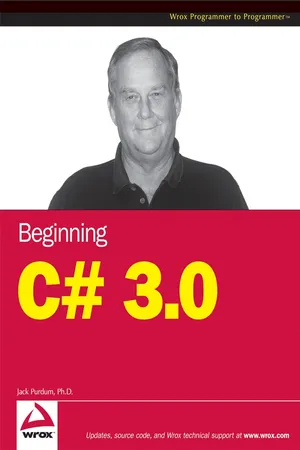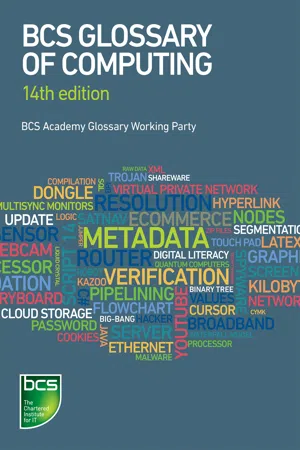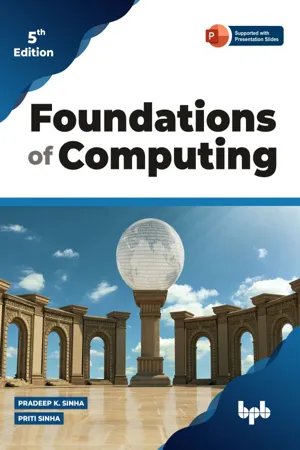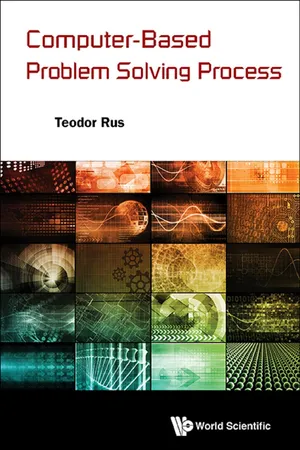Computer Science
Syntax Errors
Syntax errors are mistakes in the structure of a program's code that prevent it from being compiled or executed. These errors occur when the code violates the rules of the programming language, such as using incorrect syntax or misspelling keywords. Syntax errors can be identified by the compiler and must be fixed before the program can be run.
Written by Perlego with AI-assistance
Related key terms
5 Key excerpts on "Syntax Errors"
- eBook - ePub
Beginning C# 3.0
An Introduction to Object Oriented Programming
- Jack Purdum(Author)
- 2011(Publication Date)
- Wrox(Publisher)
Let’s take a quick overview of the three types of program errors. I will have a lot more to say about errors and debugging in later chapters. For now, however, let’s just categorize the types of program errors.Syntax ErrorsThe first type of error is a syntax error. You already know that Syntax Errors are caused when you don’t obey the syntax rules of C#. A common syntax rule you might make in the beginning is forgetting to terminate each program statement with a semicolon.Intellisense does an excellent job of catching Syntax Errors. While you may hate the squiggly line that Intellisense displays, it’s a lot easier for Intellisense to detect and isolate Syntax Errors than it is for you to do it yourself.Semantic ErrorsA semantic error occurs when you obey the syntax rules of the language but are using the statement out of context. For example, a sentence in English is expected to have a noun and a verb. Consider the sentence “The dog meowed.” This sentence does obey the rules of having a noun and a verb, but the context of the sentence is out of whack. Dogs don’t meow, therefore the context of the statement is incorrect.The error message I showed you earlier:The name 'i' does not exist in the current contextrefers to a type of semantic error. There may well be a variable named i defined somewhere in the program, but it is not currently in scope. That is, you are trying to use i when it is out of scope. Intellisense does a good job of detecting semantic errors.Logic ErrorsLogic errors are those errors that remain after all the semantic and Syntax Errors have been removed. Usually, logic errors manifest themselves when the result the program produces doesn’t match the result your test data suggest it should produce. Most of the time, logic errors are found in the Process Step you studied in Chapter 3. Logic errors occur when you implement the algorithm for solving the problem incorrectly.The key to fixing logic errors is to be able to reproduce the error consistently. A repeatable logic error is much easier to track down and fix than an error that appears to be occurring randomly. (In Chapter 5 you will learn the details of using some of the tools Visual Studio provides to help you detect and isolate program bugs.) - eBook - ePub
- Arnold Burdett, Dan Bowen, Diana Butler, Aline Cumming, Frank Hurvid, Adrian Jackson, John Jaworski, Percy Mett, Thomas Ng, Penny Patterson, Marianne Scheer, Hazel Shaw, Alfred Vella, John Woollard, David Fuller(Authors)
- 2016(Publication Date)
- BCS, The Chartered Institute for IT(Publisher)
run-time errors are errors detected during program execution. These errors, such as overflow and division by zero, can occur if a mistake is made in the processing algorithm or as a result of external effects not catered for by the program, such as lack of memory or unusual data.Compilation errors are errors detected during compilation and are usually Syntax Errors (see below).Linking errors occur when a compiled program is linked to library routines. For example, if a particular subroutine is not present in the library or the number of parameters provided is wrong.Syntax Errors occur either when program statements cannot be understood because they do not follow the rules laid down by the programming language, statement Syntax Errors , or when program structures are incorrectly formed, program Syntax Errors or structure errors . Examples of statement Syntax Errors include wrong punctuation and misspelling of reserved words and variables. Examples of program Syntax Errors include control structures incorrectly nested or incorrectly terminated.Logical errors are mistakes in the design of a program, such as the use of an inappropriate mathematical formula or control structure, recognised by incorrect results or unexpected displays. It is unlikely to generate an error message because the error is in the program design.Figure C6.1 Examples of trace tablesRun including: run-time is putting a program or information system into action so that it can perform the data processing it was designed to do.Run-time is the time during which a program or information system is in operation. Often data has to be provided during run-time and some effects, such as run-time errors , can only be detected when the system is operating.Breakpointis a position within the program where the program is halted as an aid to debugging. While the program is halted, the programmer can investigate the values of variables, memory locations and registers. This provides additional information to help locate errors, particularly run-time errors. - eBook - ePub
Instant Approach to Software Testing
Principles, Applications, Techniques, and Practices
- Anand Nayyar(Author)
- 2019(Publication Date)
- BPB Publications(Publisher)
16 ]. Introduction of errors in a software program is subject to human mistakes and can be classified as follows:- Logical error: Missing or inadequate or unclear interpretation in the source code.
- Message error: Compiler error messages for the source code that are misinterpreted.
- Navigation error: Moving from one function to another function is not correctly coded.
- System error: Memory leak, hardware, and operating system related errors.
- Incorrect requirements: Incorrect or wrong requirements.
- Performance error: Anything related to the performance leads to performance error.
- Data error: Incorrect data update in the database due to wrong data types used.
- Database error: Improper normalization of database schema/design.
- Standards: Standards not followed like improper exception handling, improper coding/design standards.
- Incorrect design: Wrong or incorrect design.
- Typographical error: Grammatical/lexical mistake in documents/source code.
- Comments: Comments in the source code are not properly mentioned.
- Variable declaration error: Wrong declaration/usage of variables in the source code, mismatch in data types of variables.
- Boundary value analysis error: Boundary conditions are not coded properly.
- Complexity error:
- eBook - ePub
Foundations of Computing
Essential for Computing Studies, Profession And Entrance Examinations - 5th Edition
- Pradeep K. Sinha, Priti Sinha(Authors)
- 2022(Publication Date)
- BPB Publications(Publisher)
As compared to logic errors, Syntax Errors are easier to locate and correct because almost all language processors detect Syntax Errors automatically. When a language processor processes the source code of a program, it indicates on the source listing of the program each program statement having one or more Syntax Errors, and gives hints regarding the nature of the error. Programmers use these error messages to rectify all Syntax Errors in their programs. Hence, it is relatively easier to detect and correct Syntax Errors. Note that in high-level languages such as FORTRAN and COBOL, a single error in a program often causes generation of multiple error messages by the compiler/interpreter. There are two reasons for this. One is that high-level language instructions often convert to multiple machine instructions. The other one is that symbolic instructions are often dependent upon other instructions. Hence, if a program instruction contains an error that defines a field name, all program instructions that use that field name will have an error message. The error message will indicate that a field used is not a defined name. In such cases, removal of the single error will result in the removal of all associated error messages. Debugging a Program for Logic Errors Unlike Syntax Errors, a computer does not produce any error message for logic errors in a program. Hence, logic errors are more difficult to locate and correct than Syntax Errors. However, once the testing of a program indicates the presence of a logic error in it, a programmer uses one or more of the following methods to locate and correct the error: Doing hand simulation of the program code. One approach is to take a printout of the source code of the program and go through its execution manually with the test data input that produced incorrect results - eBook - ePub
- Teodor Rus(Author)
- 2015(Publication Date)
- WSPC(Publisher)
Chapter 16 Software Tools for Correct Program DevelopmentPrograms are programming language expressions developed by people (programmers) who are experts on the syntax and the semantic rules defining the programming language they use. However, since program development is a human activity, according to the Latin proverb “errare humanum est”, which translates in “to err is human”, a program may contain errors. So, the problem faced by software developers becomes the development of tools that allow programmers to create correct programs during computer based problem solving process. For that the software developers need first to define the meaning of the expression “correct program”. Since programs are algorithms expressed using programming languages, the program correctness becomes the correctness of the algorithms they represent. But irrespective whether we talk about the correctness of the algorithm or of the program, we need to remember that programs (or algorithms) are language expressions. And as language expressions they may contain two kind of errors: syntactic errors and semantic errors. Syntactic errors are violations of the language syntax during program development. Since language syntax is usually formally specified, Syntax Errors can be handled by the compiler. Semantic errors however are more difficult to handle.Theoretically, semantic correctness of an algorithm is asserted saying that the algorithm is correct with respect to a specification. But a specification is also a language expression which is developed by a human and it can contain syntactical and semantical errors. Thus a correctness proof would have to be a mathematical proof, assuming both the algorithm and specification are given formally. In particular, correctness proof is expected to be the correctness assertion for a given program implementing the algorithm on a given machine. Further, the problem is discussed in the domain of logic, namely Proof Theory
Index pages curate the most relevant extracts from our library of academic textbooks. They’ve been created using an in-house natural language model (NLM), each adding context and meaning to key research topics.




